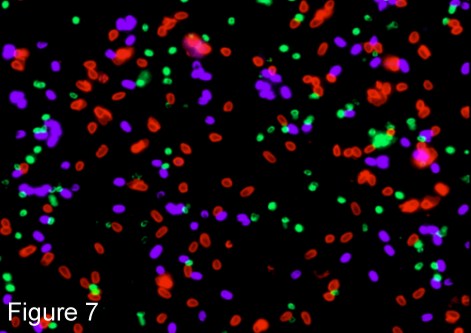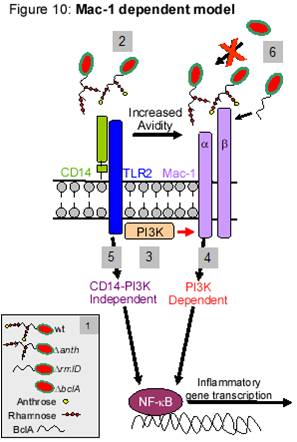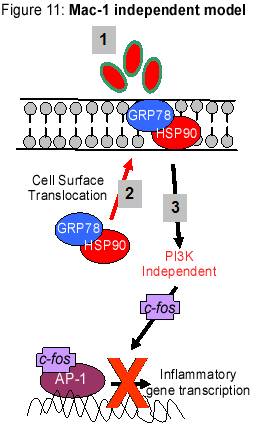 |
|
Project 5: The Immune Response to
Bacterial Spores
It
is clear that the marginal
zone of the spleen is particularly involved in the antibody response to
bacteria and bacterial products. We have chosen to study the immune
response
to the inert metabolically inactive spores of gram positive bacilli as
model antigens since these are trapped very efficiently in the marginal
zone and they do not express the various mitogenic components expressed
by the vegetative forms. |
|
 Approaches Approaches
Generation of
Monoclonal Antibodies
Panels
of mouse monoclonal antibodies
were made against B. subtilis, B.
thuringiensis B. cereus
and B. anthracis spores by immunization with intact
native spores
(or a mixture of 40kGy irradiated DAmes and Sterne strains in the case
of B. anthracis). These antibodies were purified,
conjugated with
fluorochromes, and screened for specificity by ELISA and by flow
cytometry.
In each case multiple monoclonal antibodies were obtained which were
specific
for the immunizing spore species and did not cross-react with spores of
other closely related organisms or vegetative forms of these bacilli.
These
antibodies also discriminate between mixtures of spores (Fig. 7).
|
Anthrax-Spore host Interactions
The
spore-forming bacterium Bacillus
anthracis (BA) is the causative agent of anthrax in animals and
humans. The use of B. anthracis
as a bioweapon depends upon the spore’s entrance into the body, its
uptake by and germination within host cells, and the host’s response to
toxins expressed by the vegetative bacteria. Because the spore is
the infectious form of B. anthracis, the interaction between its
outermost layer, or exosporium, and the host receptors is considered a
vital step in the initiation of disease. Although a previous paradigm
maintained that successful infection involved a step of intracellular
germination and outgrowth, macrophages and other cell types have been
shown to play an important role in early control of the pathogen
because they efficiently kill phagocytosed spores upon germination. The
destruction of germinated spores is enhanced by factors that promote
macrophage activation, including cytokine production and
spore-opsonization. Of particular interest are the mechanisms
governing initial contact, spore uptake, spore-induced activation, and
intracellular spore termination, as these processes have yet to be
elucidated fully. We recently showed that attachment and uptake of B. anthracis spores
by macrophages occurs through a CD14-enhanced, Mac-1-dependent pathway
mediated by the major exosporium protein BclA. Absence of BclA on
spores results in indiscriminate entry into a variety of cell types in
addition to macrophages, and, paradoxically, B. anthracis virulence. It appears,
therefore, that BclA promotes the selective uptake of B. anthracis
spores by host macrophages, wherein the spores are most susceptible to
elimination. Despite the capacity of macrophages to kill spores
efficiently, all phagocytosed spores are not always killed; the
surviving spores lead to anthrax. In our studies using phagocytic
cells, we have shown that engulfment of spores and the survival of
spore-bearing cells depend on NF-kappaB signaling pathways that promote
the production of inflammatory proteins by means of a PI3 kinase
pathway. . A deeper understanding of these mechanisms will enable the
development of strategies to enhance spore extermination prior to or
during germination, thus preventing bacterial development, the
elaboration of toxins, and disease.
A deeper understanding of these mechanisms will enable the development
of strategies to enhance spore extermination prior to or during
germination, thus preventing bacterial development, the elaboration of
toxins, and disease.
|


|
References
Lisanby, N., Swiecki M.K.,
Dizon, B., Pflughoeft. K., Koehler T., Kearney J.F. Cathelicidin
administration protects mice from Bacillus
anthracis spore challenge. J.
Immunol: 181:4989-5000, 2008
McPherson, S.A., Li, M., Kearney, J.F.,
Turnbough, C.L., Jr. ExsB, an unusually
highly phosphorylated protein required for the stable attachment of the
exosporium of Bacillus anthracis.
Mol Microbiol: 2010
Jun;76(6):1527-38. Epub 2010 Apr 23.
Oliva,
C., Turnbough, C. L. , Jr., and Kearney, J. F. 2009. CD14-Mac-1 interactions
in Bacillus anthracis spore
internalization by macrophages. Proc
Natl Acad Sci U S A: 106:13957-13962, 2009.
Oliva, C. R., Swiecki,
M. K. , Griguer, C. E. , Lisanby, M. W. , Bullard, D. C. , Turnbough,C.
L., Jr., and Kearney,J.F. The integrin Mac-1 (CR3)
mediates internalization and directs Bacillus
anthracis spores into professional phagocytes. Proc Natl Acad Sci U S A: 105:1261-1266,
2008.
|